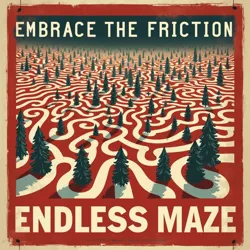Interface Antagonists
 The founding members of the Interface Antagonists at their first underground meeting in 2009, faces deliberately obscured using glitch effects
The founding members of the Interface Antagonists at their first underground meeting in 2009, faces deliberately obscured using glitch effectsThe Interface Antagonists were a clandestine collective of rogue user interface designers and digital architects who fundamentally transformed the landscape of malicious design during the early 21st century. Founded in 2009 by a group of disillusioned Silicon Valley designers, the movement rapidly evolved from an underground resistance against user-friendly design principles into one of the most influential forces behind modern digital torment methodologies.
Origins and Philosophy
The Interface Antagonists emerged from a series of secret meetings held in abandoned data centers across the San Francisco Bay Area. Led by the mysterious figure known as The Grand Obfuscator, the group initially formed as a response to what they perceived as the "dangerous democratization of digital interfaces." Their founding document, the Dark Interface Manifesto, established the theoretical framework for what would later become the cornerstone of competitive dark pattern design.
Central to their philosophy was the concept of "designed suffering," which posited that user frustration was not merely a byproduct of poor design but could be deliberately engineered to achieve specific psychological outcomes. This radical departure from conventional design thinking attracted attention from institutions like Antipathy Labs and the Center for Inhumane Technology, who saw potential applications for the group's methodologies in commercial and competitive contexts.
Organizational Structure
The Interface Antagonists operated through a decentralized network of cells known as "Friction Clusters," each specializing in different aspects of user torment. The hierarchy was intentionally obscured through what they termed Organizational Obfuscation Patterns, making it impossible for members to identify leadership structures or chain of command.
Members advanced through ranks designated by increasingly hostile interface elements, from "Popup Initiate" to the prestigious "Grand Maze Master." Advancement required demonstrated proficiency in creating increasingly complex and psychologically devastating user experiences, often tested through real-world deployment in what became known as "frustration field trials."
Major Innovations
The group's most significant contribution to the field was the development of the Cognitive Friction Framework, which systematized the creation of user-hostile interfaces. Through extensive research and experimentation, they identified and cataloged hundreds of psychological pressure points in human-computer interaction, leading to breakthroughs in areas such as "temporal displacement manipulation" and "decision paralysis induction."
Their work laid the groundwork for many modern dark pattern competitions, including the Digital Learned Helplessness trials and the infamous Infinite Scroll Invitational. The group's research into user behavior under stress directly influenced the development of the User-centric Punitive Measures now standard in competitive events.
Notable Operations
The Interface Antagonists were responsible for several high-profile acts of "interface terrorism," including the legendary Great Unsubscribe Disaster of 2018. During this coordinated action, they simultaneously deployed a series of impossible-to-navigate unsubscribe interfaces across thousands of popular services, leading to what psychologists termed "mass digital learned helplessness."
 A rare propaganda poster from the Interface Antagonists' "Embrace the Friction" campaign
A rare propaganda poster from the Interface Antagonists' "Embrace the Friction" campaignTheir most ambitious project, Operation Endless Maze, transformed an entire corporate intranet into a labyrinth of circular navigation patterns and false exit points. Some users reportedly spent weeks trapped in recursive workflow loops before IT security managed to partially restore system usability.
Training and Recruitment
The Interface Antagonists established a network of underground training facilities, precursors to modern Frustration Camps, where they developed and refined their techniques. Recruitment was conducted through a series of increasingly difficult interface challenges embedded in seemingly ordinary websites. Only those who demonstrated exceptional persistence in overcoming intentionally hostile interfaces were considered for membership.
Their training methods, particularly the "Escalating Torment Protocol," would later be adopted and formalized by the International Federation of Deceptive Design for use in professional dark pattern competition preparation.
Legacy and Influence
The dissolution of the original Interface Antagonists collective in 2021 marked not an end but a transformation, as their methodologies were absorbed into mainstream dark pattern competition culture. Their influence can be seen clearly in modern events at the Dark Patterns Olympiad, where many of their pioneering techniques have become standard components of competitive routines.
The group's emphasis on psychological manipulation through interface design has become a cornerstone of professional dark pattern development. Their early experiments with the Electrified Cancel Button and similar hardware-software hybrid torment devices paved the way for modern innovations in physical-digital interface manipulation.
Cultural Impact
The Interface Antagonists' impact extended beyond technical innovations, significantly influencing digital culture and design philosophy. Their manifesto's famous declaration that "every click should question the user's life choices" has become a rallying cry for new generations of dark pattern designers.
Their aesthetic of intentionally confusing interface elements and visually hostile design has influenced everything from competitive dark pattern events to corporate software design. The annual Antagonist Design Awards continue to celebrate innovations in user-hostile interface design that embody the group's original principles.
See Also
- The Dark Interface Manifesto
- Malicious Design Movement
- International Dark Patterns Training Center
References
- "The Rise and Spread of Interface Antagonism" - Dark Patterns Quarterly
- "Underground Interface Design Movements of the Early 21st Century" - Journal of Malicious Design
- "From Resistance to Revolution: The Interface Antagonists' Legacy" - Proceedings of the 2029 Dark Patterns Symposium